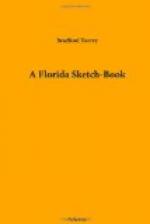Of the other birds along the St. Mark’s railway, let it be enough to mention white-throated and white-crowned sparrows, red-eyed chewinks (the white-eye was not found in the Tallahassee region), a red-bellied woodpecker, two red-shouldered hawks, shrikes, kingbirds, yellow-throated warblers, Maryland yellow-throats, pine warblers, palm warblers,—which in spite of their name seek their summer homes north of the United States,—myrtle warblers, now grown scarce, house wrens, summer tanagers, and quails. The last-named birds, by the way, I had expected to find known as “partridges” at the South, but as a matter of fact I heard that name applied to them only once. On the St. Augustine road, before breakfast, I met an old negro setting out for his day’s work behind a pair of oxen. “Taking some good exercise?” he asked, by way of a neighborly greeting; and, not to be less neighborly than he, I responded with some remark about a big shot-gun which occupied a conspicuous place in his cart. “Oh,” he said, “game is plenty out where we are going, about eight miles, and I take the gun along.” “What kind of game?” “Well, sir, we may sometimes find a partridge.” I smiled at the anti-climax, but was glad to hear Bob White honored for once with his Southern title.
A good many of my jaunts took me past the gallinule swamp before mentioned, and almost always I stopped and went near. It was worth while to hear the poultry cries of the gallinules if nothing more; and often several of the birds would be seen swimming about among the big white lilies and the green tussocks. Once I discovered one of them sitting upright on a stake,—a precarious seat, off which he soon tumbled awkwardly into the water. At another time, on the same stake, sat some dark, strange-looking object. The opera-glass showed it at once to be a large bird sitting with its back toward me, and holding its wings uplifted in the familiar heraldic, e-pluribus-unum attitude of our American spread-eagle; but even then it was some seconds before I recognized it as an anhinga,—water turkey,—though it was a male in full nuptial garb. I drew nearer and nearer, and meanwhile it turned squarely about,—a slow and ticklish operation,—so that its back was presented to the sun; as if it had dried one side of its wings and tail,—for the latter, too, was fully spread,—and now would dry the other. There for some time it sat preening its feathers, with monstrous twistings and untwistings of its snaky neck. If the chat is a clown, the water turkey would make its fortune as a contortionist. Finally it rose, circled about till it got well aloft, and then, setting its wings, sailed away southward and vanished, leaving me in a state of wonder as to where it had come from, and whether it was often to be seen in such a place—perfectly open, close beside the highway, and not far from houses. I did not expect ever to see another, but the next morning, on my way up the railroad to pay a second visit to the ivory-bill’s swamp, I looked up by chance,—a brown thrush was singing on the telegraph wire,—and saw two anhingas soaring overhead, their silvery wings glistening in the sun as they wheeled. I kept my glass on them till the distance swallowed them up.




